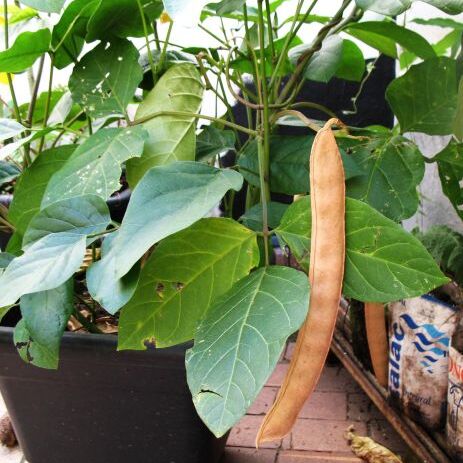Vine, stems glabrescent. Leaves pinnate trifoliolate, leaflets' to 20 cm long, broadly ovate, apically obtuse with a blunt apiculum, glabrate. Inflorescence slender in flower, to 30 cm long; bracteoles obtuse, ca. 2 mm long; pedicels ca. 2 mm long. Flowers lavender; calyx tubular, ca. 14 mm long, sparingly pubescent, the upper lip about equalling the tube, emarginate, the lowest tooth slender, ca. 2.5 mm long, longer than the ovate lateral teeth; standard 2.75 cm long. Legume to 30 cm long, 3.5 cm thick, woody, oblong with a short apical beak and short basal stipe, explosively dehiscent, the valves glabrescent, each with a sutural rib and an additional rib ca. 5 mm from the sutural rib; seeds ca. 29 mm long, oblong, compressed, white or ivory, the hilum ca. 9 mm long, about 1/2 as long as the seed.
Herbs, annual, subshrubby, 0.6-1(-2) m, wholly pubescent or glabrescent. Stipules small, deciduous; leaflets thin, ovate or elliptic, 8-18 × 5-8 cm, base cuneate or rounded, apex acute. Racemes solitary, 15-25(-40) cm including peduncle. Flowers 1-5 at nodes of rachis. Calyx ca. 1.5 cm, upper lip truncate, as long as calyx tube, lower lip with deltoid lobes. Corolla purplish or white and purple; standard ca. 2.2 cm in diam., base with 2 semiorbicular, reflexed auricles, claw flat and broad, ca. 5 mm; wings obovate-oblong; keel auriculate and clawed. Legumes thickly leathery, ligulate, 20-30 × 2.5-4 cm, each valve with extra rib ca. 5 mm from sutural rib. Seeds white, elliptic, ca. 3 × 2 cm; hilum not more than 1.5 cm. Fl. May-Jul, fr. Oct.
Robust, climbing woody shrub, capable of becoming a perennial climber, up to 2 m high; leaflets elliptic or ovate-elliptic, pubescent, (60)110-200 x (40)70-100 mm; petiole (10)25-130 mm long; stipules early caducous. Peduncles 50-135 mm long, with 8-10 flowers, flowers up to 2.5 mm long; bracteoles obtuse, ± 2 mm long. Calyx sparsely pubescent, upper lip 10-15 mm long, lower lip 6-10 mm long. Corolla pink to purple; standard broadly obovate. Pod oblong, very long, (13)16-35 x 3-4 cm, with two longitudinal ribs near the upper suture, 8-15-seeded, spirally dehiscent; seeds oblong or narrowly ellipsoid, 13-21 x 10-15 mm, white, occasionally greyish or black, with a brown hilum extending to less than half the length of the seed.
A perennial climber, although short kinds do occur. Often it is a more bushy plant than the sword bean. Plants up to 1.5 m long. Stems can be hairy. Leaves have 3 leaflets. The leaflets are oval and 5.7-20 cm long by 3.2-11.5 cm wide. The leaf tends to be wedge shaped at the base. The leaf stalks are 2.5-11 cm long. Flowers are red/purple. They occur on flower clusters 5-12 cm long and with flower cluster stalks which are 10-34 cm long. The individual flower stalks are 2-5 mm long. Pods are long and sword shaped. Pods can be 15-35 cm long. Seeds are white with a light brown hilum half as long as the seed. Seeds are 2 cm long, by 1 cm across.
Usually an erect, bushy, annual crop plant, 1-2 m high, but can become perennial climber up to 10 m high; stems glabrous to appressed-pubescent. Leaves pinnately trifoliolate. Leaflets elliptic or ovate-elliptic, glabrescent to sparsely pubescent on both surfaces. Inflorescences pedunculate, 60-400 mm long. Calyx sparsely pubescent; tube 6-7 mm long, truncate. Petals standard rose to purple, 27-30 mm long. Flowering time Feb.-June. Pod linear-oblong, each valve with a sutural rib and an extra rib below this. Seeds white with a brownish mark around hilum.
Leaflets 6–20 × 3–12 cm, elliptic or ovate-elliptic, subacute to shortly acuminate, glabrescent to sparsely pubscent on both surfaces; petiole 2–11 cm long; stipules soon deciduous.
Pods 15–35 × 3–3.5 cm, linear-oblong, each valve with a sutural rib and an extra rib just below this, pubescent, glabrescent.
Inflorescences 6–40 cm long, long-pedunculate; pedicels 2–5 mm long; bracteoles c. 2 mm long, obtuse.
Usually an erect bushy annual crop plant 1–2 m tall, but can become a perennial climber to 10 m.
Seeds white with a brownish mark round the hilum, 14–21 × 10–15 × 7–11 mm; hilum 5.5–9 mm long.
Calyx sparsely pubescent; tube 6–7 mm long; upper lip 4–5 mm long, truncate.
Flowers rose, mauve or white with a red base.
Standard rose to purple, 2.7–3 cm long.
Stems glabrous to appressed pubescent.
Climbing on fences and trees

